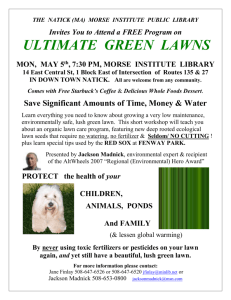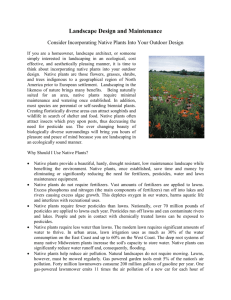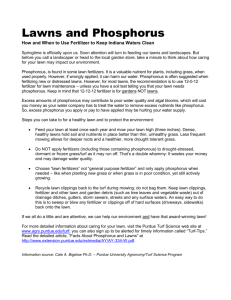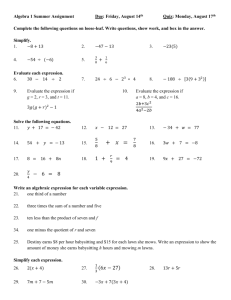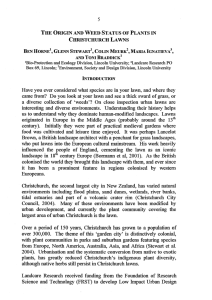Preventive Medicine for Lawns Willie Chance, Houston County Extension Agent
advertisement
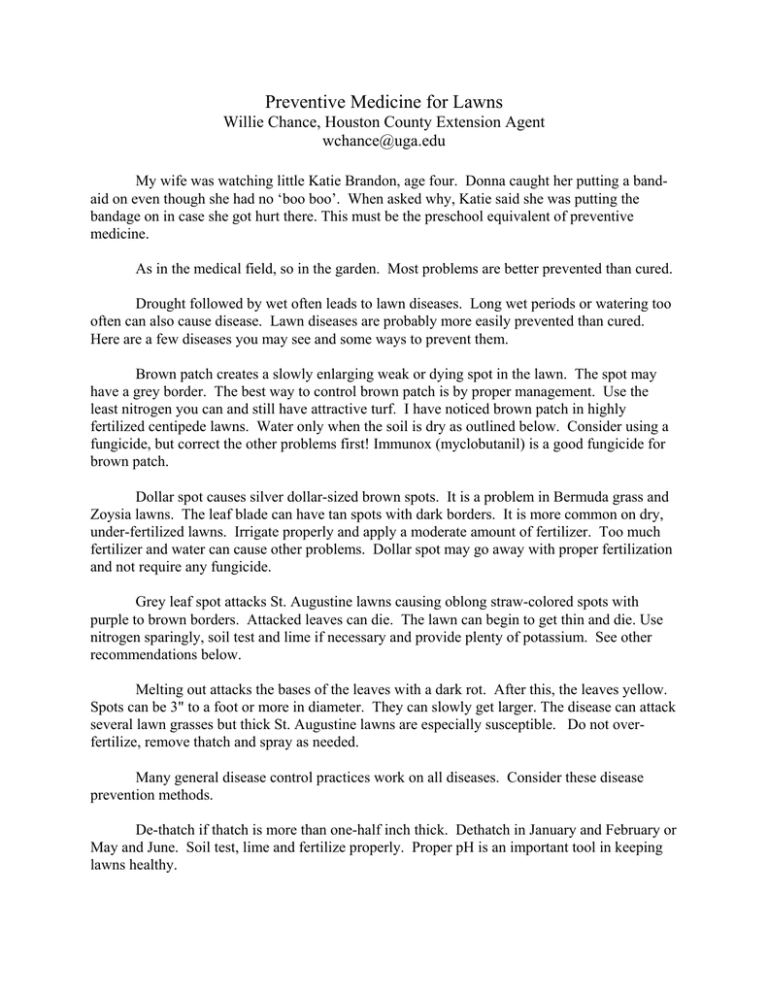
Preventive Medicine for Lawns Willie Chance, Houston County Extension Agent wchance@uga.edu My wife was watching little Katie Brandon, age four. Donna caught her putting a bandaid on even though she had no ‘boo boo’. When asked why, Katie said she was putting the bandage on in case she got hurt there. This must be the preschool equivalent of preventive medicine. As in the medical field, so in the garden. Most problems are better prevented than cured. Drought followed by wet often leads to lawn diseases. Long wet periods or watering too often can also cause disease. Lawn diseases are probably more easily prevented than cured. Here are a few diseases you may see and some ways to prevent them. Brown patch creates a slowly enlarging weak or dying spot in the lawn. The spot may have a grey border. The best way to control brown patch is by proper management. Use the least nitrogen you can and still have attractive turf. I have noticed brown patch in highly fertilized centipede lawns. Water only when the soil is dry as outlined below. Consider using a fungicide, but correct the other problems first! Immunox (myclobutanil) is a good fungicide for brown patch. Dollar spot causes silver dollar-sized brown spots. It is a problem in Bermuda grass and Zoysia lawns. The leaf blade can have tan spots with dark borders. It is more common on dry, under-fertilized lawns. Irrigate properly and apply a moderate amount of fertilizer. Too much fertilizer and water can cause other problems. Dollar spot may go away with proper fertilization and not require any fungicide. Grey leaf spot attacks St. Augustine lawns causing oblong straw-colored spots with purple to brown borders. Attacked leaves can die. The lawn can begin to get thin and die. Use nitrogen sparingly, soil test and lime if necessary and provide plenty of potassium. See other recommendations below. Melting out attacks the bases of the leaves with a dark rot. After this, the leaves yellow. Spots can be 3" to a foot or more in diameter. They can slowly get larger. The disease can attack several lawn grasses but thick St. Augustine lawns are especially susceptible. Do not overfertilize, remove thatch and spray as needed. Many general disease control practices work on all diseases. Consider these disease prevention methods. De-thatch if thatch is more than one-half inch thick. Dethatch in January and February or May and June. Soil test, lime and fertilize properly. Proper pH is an important tool in keeping lawns healthy. Hard compacted lawns can also lead to disease problems. Check to see how hard the soil is. If areas of turf die and the soil is hard, till the soil before you replant. Core aerate hard soils that still have turf growing on them. Contact your local Extension Office for more details. In dry weather, water with three-quarter to one inch of water once a week or one-half to three-quarter inch twice a week. A better method is to wait until the lawn dries and then apply three-quarter inches of water. The lawn will turn grey and the leaves will curl up when it needs water again. Wait until the lawn indicates it is dry to water again. Do not water every other day or every day! How long will it take my system to put out three-quarter inches of water? Put a rain gauge, empty cat food or tuna can or pie pan out on the lawn. Turn on the system. Time it to see how long your system will take to apply three quarter inches of water. Water this long each time. Water between 10:00 p.m. and 10:00 a.m. to lower the chance of disease. Use slow release fertilizers on St. Augustine. Do not fertilize diseased lawns until you diagnose the disease. Do not fertilize very dry lawns or lawns that have been watered too often. Fungicides should help slow disease spread while you correct the cultural problem that caused the disease. Spray one to three times as needed with an approved fungicide. Fungicides include Immunox, Banner Maxx, Cleary’s 3336 and others. Read and follow all label directions. Make sure you are using a fungicide that will control the type of disease you are dealing with. To see which fungicide is best for your problem, you must diagnose your disease. Call your local Extension Office for help. We are not able to go see every lawn, but you can bring us a sample of the affected turf. Take a sample at least the size of your hand. Take the sample at the edge of the dying spot. The sample must contain both living and dead grass. We need to see the grass that is currently in the process of dying. Once you identify your disease problem, see this publication to select the proper fungicide - http://www.ent.uga.edu/pmh/Hm_Turf.pdf Remember that fungicides are expensive. Proper turf culture is the best disease prevention. Spraying alone will not cure many problems. Use preventive lawn medicine to keep from having these lawn diseases. Following these tips will not prevent all diseases. These practices can lessen disease severity and make diseases less likely to occur. For more information on lawn diseases – see these publications http://pubs.caes.uga.edu/caespubs/pubcd/B1233.htm or http://pubs.caes.uga.edu/caespubs/pubcd/C891.htm
